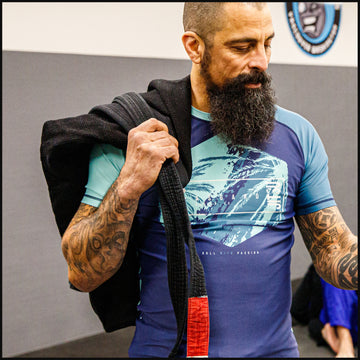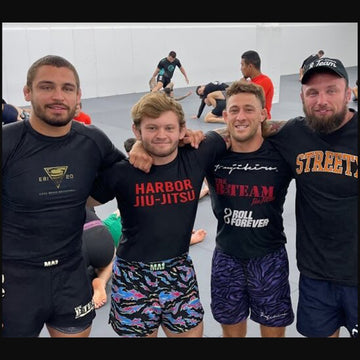If you have been training Jiu-Jitsu long enough, you have probably seen two types of grapplers—those who wear a rash guard under their gi and those who go bare-chested. Some people swear by the comfort and hygiene of a rash guard, while others prefer the traditional feel of rolling without one. But is there a right or wrong choice? And what do Jiu-Jitsu schools and competition rules actually say about it? Let’s break it down.
The Case for Wearing a Rash Guard Under Your Gi
There is a reason why most Jiu-Jitsu athletes prefer to wear a rash guard under their gi—it just makes training more comfortable. Gis can be rough, especially when they are new, and wearing a rash guard provides an extra layer of protection between your skin and the fabric. This helps prevent friction burns, irritation, and chafing, which can be a real issue during longer training sessions.
Another big advantage of wearing a rash guard is sweat management. Jiu-Jitsu is an intense, full-contact sport, and rolling in a gi can get hot fast. A good rash guard is made from moisture-wicking material, meaning it pulls sweat away from your body and helps keep you dry. Without one, sweat soaks directly into the gi, making it heavier and uncomfortable as training goes on.
Hygiene is another major factor. Gyms are full of bacteria, and while most academies do their best to keep mats clean, skin infections like ringworm and staph can still spread. Wearing a rash guard adds a layer of protection, reducing direct skin contact with your gi and your training partners. If you train regularly, wearing a rash guard can help keep your skin healthier and cut down on the risk of infections.
Going Bare Chest—Why Some Grapplers Prefer It
While rash guards are the go-to for many, some Jiu-Jitsu athletes prefer to train bare-chested under the gi. Traditionally, this was the norm, especially in Brazilian academies where wearing a rash guard under the gi was less common. Some grapplers like the way a gi feels directly on their skin, arguing that it gives them better feedback on grips and movement.
There is also the temperature factor. In extremely hot and humid climates, wearing an extra layer under the gi might feel suffocating. Some athletes find it more comfortable to go without a rash guard to keep cool.
However, the downside of skipping a rash guard is that sweat absorption becomes an issue. Without a rash guard, sweat goes directly into your gi, which means your training partners will be gripping a soaked, sweaty lapel during rolls. If you are not washing your gi after every session, this can lead to a pretty unpleasant training experience for everyone involved.
What Do Jiu-Jitsu Schools and Competitions Require?
If you train at multiple academies, you might have noticed that some schools require rash guards under the gi while others do not. Many gyms, especially those with a strong hygiene policy, encourage or even mandate rash guards to help keep the mats and training partners cleaner.
In competitions, it depends on the organization. According to IBJJF (International Brazilian Jiu-Jitsu Federation) rules, male competitors are not allowed to wear a rash guard under the gi during gi competitions. The IBJJF requires that competitors wear a gi jacket with nothing underneath except for their belt. The only exception is for female competitors, who must wear a rash guard or sports bra under their gi top.
However, in no-gi divisions, IBJJF and most other organizations require a rash guard, so it is still an essential piece of gear for any Jiu-Jitsu athlete.
So, Which Option Is Best?
Ultimately, it comes down to personal preference and gym rules. If your academy requires rash guards under the gi, then that is an easy decision. If it is optional, you have to weigh the benefits. A rash guard provides better comfort, sweat control, and hygiene, making it a smart choice for most grapplers. But if you prefer the old-school feel and your gym allows it, training without one is still an option—just make sure your gi is clean and fresh for your training partners.
If you are looking for high-quality rash guards built for comfort, durability, and performance, check out our collection [HERE]. Whether you are wearing one under your gi or for no-gi training, a good rash guard is an essential part of your Jiu-Jitsu gear.





